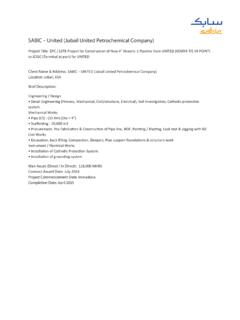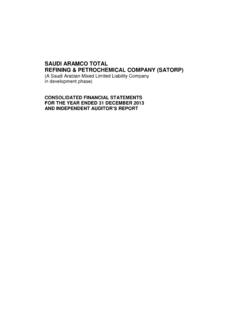Transcription of Reducing Corrosion and potential ... - NACE Jubail …
1 1 Reducing Corrosion and potential Boiler Failure with Superior Iron Transport Technology Joan Estil les, GEW&PT Product Applications Manager Boiler Manuel Soria, GEW&PT Product Applications Manager and EMEA Coordinator Abstract Boilers in Refineries and Petrochemical industries are critical systems to assure a profitable business, in most of the cases the boilers are directly related to the operating units by the Waste Heat boilers always critical as they are directly linked to the production. These systems have evolved over recent years to operate with higher drum pressures, more complex feedwater pretreatment systems, higher purity feedwater, and tighter restrictions on steam purity.
2 The reliability of these units is the primary reason for water treatment, and since the water make up is of high quality, scale deposits are of less concern and Corrosion has become the major subject to control. Special attention is needed to reduce iron pick up along the systems and avoiding that iron arriving the boiler system, as it could create iron-deposits in critical boiler areas. Commodities as Hydrazine, ammonia and phosphates are used in some places, but increasing stressing conditions demand superior technologies to better achieve results both from the energy saving point of view and on long time operation.
3 This article is intended to provide the reader with a basic understanding of the iron transport process, the way the iron-oxides could affect the heat transfer areas and will explain the advantages of superior technologies solutions with the most appropriate treatment regime for a long run plant operation without risk. 1. Introduction In recent years in Refinery and Petrochemical industry high purity make up water for boiler systems has become a standard, therefore former calcium, magnesium or silica scaling is not anymore the main concern. Nowadays condensate process contamination and / or metal Corrosion products from condensate network and boiler feed water section Corrosion have become the main source of boiler contaminants.
4 2 This paper will cover two main topics. 1) Reducing Corrosion on condensate network and boiler feed water section to minimize iron and copper concentration arriving to boiler. 2) Reducing the impact of boiler feed water metal oxides concentration in boiler water. It is improving the efficiency, Reducing the Corrosion and increasing reliability. First we will discuss the optimal chemical water treatment approach in order to reduce Corrosion on condensate and preboiler sections and second technologies to increase iron transport in boiler to avoid metal deposition on critical high flux areas. Condensate process contaminants (like Hydrocarbon, cooling water, ) and their impact on boiler fouling and Corrosion will not be covered on this paper, as this is more an upset situation that requires adequate and dedicated actions.
5 Iron and / or copper is a general potential problem while process contaminants typically only appear few times along boiler life. In cases process contaminants are more likely to be presents on recovered condensates, a condensate-polishing unit is usually implemented. Data and examples shown on this paper are related to typical refinery and chemical / petrochemical industry using demineralized water as boiler water make up. Even though they are still some plants still using Softening processes, this is the minor case in Middle East refineries and Petrochemical plants. According to water source the water preparation plant may include as primary treatment: Ion exchange, one or two pass Reverse Osmosis, Electro Dialysis Reversal (EDR) or Thermal Desalination may be used in front of Mixbed Ion Exchange or Electro Deionization units (EDI) to produce the high purity water required.
6 Other systems with pourer make up water quality may experience more severe Corrosion problems in similar boiler working conditions, as higher chlorine or sulphate depolarization ions would be present. The described Corrosion mechanism and best chemical treatment approach presented on this document can be applied to auxiliary boilers and also Waste Heat Boilers (WHB). WHB are usually more sensitive to failure than auxiliary boilers and the economical impact is much higher as they are directly linked to plant production. WHB are used in Ethylene, Ethylene Glycol, Polyethylene, Hydrogen plants, in convection sections of Refinery furnaces and in many other processes in Refinery and Chemical / Petrochemical industry.
7 3 For example iron deposits in WHB may impact system efficiency and system production in some cases, ending on boiler tube failure due to under deposit Corrosion or long term overheating will have an enormous economical impact because it will force plant shut down. On section 2 different Corrosion mechanisms will be described. We will focus the Corrosion types on condensate and boiler feed water section that will increase the metal that is picked up and transported to the boiler and also the Corrosion mechanism in boiler itself due to iron and copper deposit fouling on boiler transfer areas.
8 On section 3 boiler fouling build up due to metal load will be described and analyzed. Also the impact of this deposits on Corrosion , efficiency and finally on tube failure will be also covered. How to reduce iron and / or copper Corrosion on condensate and boiler feed water section in order to reduce the metal load to boiler will be discussed on section 4. Metal transport in boiler or how to minimize boiler tube fouling due to metal load will be the main fact on section 5 of this paper. And finally on section 6 we will summarize article conclusions. 2. Corrosion mechanisms Reduced reliability due to Corrosion attack is one of the main problems in boiler systems costing billions of dollars per year.
9 Pre-boiler Corrosion Metal transport to boiler from external equipments Pre-boiler Corrosion will include Corrosion in all steam condensate network and also in boiler feed water section. Therefore Corrosion in all areas that at the end will impact in higher iron or copper concentrations arriving to boiler will be included in this definition. Pre-boiler Corrosion defines the area where the phenomenon takes place, but it may includes different Corrosion mechanism like: Oxygen Corrosion pH related metal protective layer stability Ammonia Copper alloys associated Corrosion Galvanic Corrosion Erosion- Corrosion and Flow Accelerated Corrosion Even in the absence of oxygen iron corrodes in water.
10 Iron surface acts as a car battery, the metal surface is divided into microscopic anodes (+) and cathodes (-). Iron acts as an anode so that it is oxidized giving its electrons to the cathode. 4 The cathode in pure water is a proton or hydrogen ion (H+). When iron metal is oxidized, electrons pass from the iron surface to hydrogen ions, resulting in the formation of ferrous ion (Fe2+). The fate of the ferrous ion (Fe2+) depends on water temperature, pH, and flow conditions. At low temperatures, Fe2+ reacts with water to form insoluble ferrous hydroxide, Fe(OH)2. If the stream velocity is high enough, colloidal Fe(OH)2 is swept into the water and carried downstream to deposit elsewhere.








![18.2% Ethylene - Vinyl Acetate [EVA] copolymer](/cache/preview/9/f/4/0/6/b/c/7/thumb-9f406bc7cf3a6248c0295bb5a269f78e.jpg)
